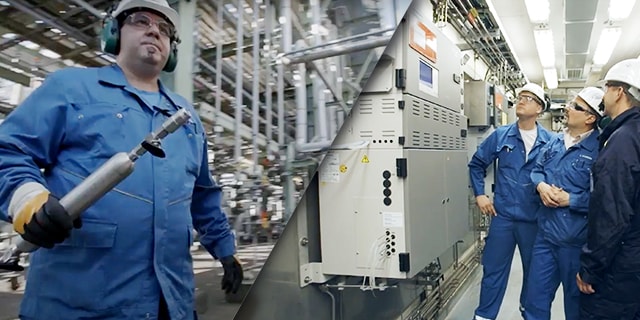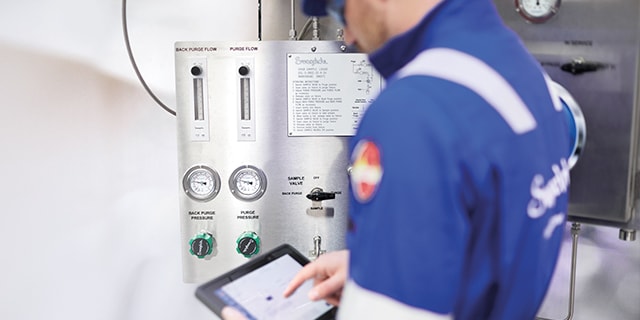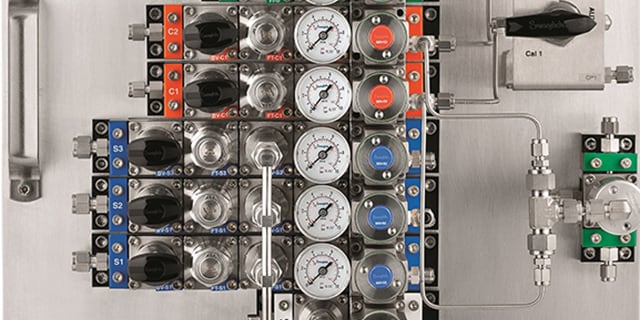How to Safely Sample High-Viscosity Fluids in Refineries

How to Safely Sample High-Viscosity Fluids in Refineries
Matt Dixon
Modern refineries are tasked with maximizing value from the entirety of their production processes. Capturing that full value requires optimizing all products and byproducts that result from the refining process.

Like any refined oil product, successfully capturing bitumen’s value requires ongoing sampling for quality and consistency. But bitumen is a high-viscosity fluid, and sampling such a fluid—often performed via grab sampling—presents unique and challenging differences compared to traditional methods. Let’s explore some of the considerations that should be made when sampling bitumen or other high-viscosity fluids and liquids.
Avoiding Costly Clogs
High-viscosity liquids have the tendency to solidify if they are not kept at the proper temperature, typically at least 20°C/68°F above their pour temperature. That means high-viscosity fluid sampling systems must incorporate the appropriate heating elements into their designs in order to maintain viscous fluid flow and avoid potential solidification and clogs within the system. Clearing a clogged line may require technicians to rod the lines, which can be messy and potentially dangerous, and can cause downtime.
Maintaining the proper temperature throughout the entirety of your sampling apparatus is important, from your lines to the point of dispensing into your container. Simplifying the design of your sampling system can help make it easier for you to maintain the appropriate temperature. For example, you should minimize the number of tube bends and extraneous components within the system. Additionally, you can incorporate what is known as a stinger nozzle, which uses a steam jacket to keep the system media hot through its point of exit.
 Notes from the Field
Notes from the Field
“Clogs are one of the biggest problems we see when helping our customers with their bitumen sampling systems. Once your system solidifies, it’s very difficult to get it flowing properly again. All of the system media needs to be remelted, and there will inevitably be cold spots that can be challenging to overcome. Oftentimes, a solidified bitumen line will require mechanical intervention—and that can get expensive. First, there’s the downtime required to perform the work. Secondly, asphalt typically flows through
1-inch tubing lines, and replacement parts are costlier than smaller line sizes. Avoiding clogs by taking the appropriate preventive measures is important.”

Bernhard Montenari,
Regional Field Engineer
Swagelok Dusseldorf
 Capturing Samples Safely
Capturing Samples Safely
The heat required for successful high-viscosity fluid sampling means that special considerations must be taken to maintain operator safety throughout the sampling process. Bitumen typically flows between the range of 204°C/400°F to 260°F/500°F, meaning that contact with the fluid can cause severe burns.
A few things can be done to mitigate these sorts of safety hazards. The first is incorporating a “no bottle, no flow” mechanism into your sampling system. This technology disables the system from dispensing any fluid unless it senses a proper container is in place to collect the sample. This can help prevent accidental dispensing, which not only creates a potential safety hazard but can create a difficult mess that will need to be cleaned up. Here, it is also important to use the appropriate container, typically something metallic, which can handle the high temperatures.
Another safety measure to put in place is an enclosure surrounding the sampling point, which can protect operators from any potential splashing while the sampling is being dispensed. Such an enclosure can also be steam-heated to best maintain the appropriate temperature and prevent clogging.
Finally, it’s critical to ensure that all components that make up your bitumen sampling system—including tube fittings, valves, and more—are properly rated for the required high temperatures of the system media. Work with your supplier to be sure you’re selecting the appropriately rated components.
Working With Sampling Specialists
Sampling, whether it’s in high-viscosity applications or any other application in your facility, is an important part of the process to help ensure the delivery of high-quality products to your customers. It’s how you validate the composition of your fluids, ensure regulatory compliance, and maintain overall profitability.
For these reasons, working with a supplier who can provide you with advice and best practices for constructing and using critical sampling systems can be helpful. Swagelok field engineers provide consultation on sampling to refinery employees around the world. If you’re encountering challenges related to high-viscosity fluid sampling or product sampling in general, field engineers can help. In the meantime, we have many resources dedicated to helping industrial professionals improve their sampling practices—read more of our best sampling advice using the link below.
–Bernhard Montenari ”
Related Articles

Analyzing Your Sampling Needs
Trying to determine whether grab sampling or online analysis is the best option to monitor your process conditions? We put together a convenient checklist to help guide you to a solution that suits your operations.

How to Reduce Emissions at Sampling Points
As refineries, chemical plants, and other facilities seek new ways to reduce fugitive emissions, one strategy can be relatively simply and cost-effective: specifying closed-loop sampling systems.

Tips to Maintaining a Representative Sample in an Analytical Instrumentation System
Maintaining a representative sample within an analytical instrumentation system can be difficult. Learn how to identify major issues and avoid complications associated with a compromised representative sample from the experts at Swagelok.

